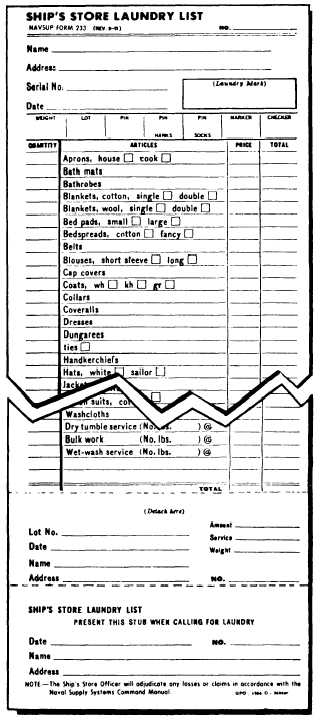| |
stenciled before they are sent to the laundry, this
type of control will generally be unnecessary.
Once bulk work is accepted it is the responsi-
bility of the laundry to make sure it is properly
identified from start to finish. You do not have
to identify individual items in bulk lots brought
to the laundry, but you do need to put some type
of marker with each lot so that you can identify
it during any phase of processing. You can make
your own markers, or flags, from a duck fabric.
Cut squares about 8 to 12 inches and hem them.
Then stencil one marker for each division, service
group, or any activity that brings bulk work to
you. When bulk lots are brought to the laundry,
put the proper identification markers on them.
You can use the same markers week after week.
In addition to these markers, the division/
department name should be stenciled on the side
of the bag in case the marker gets lost during the
process.
In the event you are required to split a lot, put
the right markers on every part of it. All markers
remain with lots and portions of lots during the
complete washing and processing cycle. Put the
marker in the washer with the load, and identify
the load on the shell of the washer with chalk.
If it is necessary that you put more than one lot
in the washer to get full capacity, use a proper
size laundry net for the smallest lot. When more
than one net is required for the same lot, use a
marker for each net.
All soiled divisional bulk bags delivered to the
laundry should be kept separate from clean
laundry. In smaller laundries where space is
limited, an effort should be made to have all clean
laundry picked up after it is completed.
IDENTIFYING INDIVIDUAL LOTS
Ship’s laundries use a Ship’s Store Laundry
List, NAVSUP Form 233, so officers and CPOs
may identify what they have sent to the laundry
(fig. 5-7).
Normally, the form contains blanks at the top
for the name of the ship, name of customer, rank
or rate, social security number, date, and laundry
mark. There is usually space for a Customer’s-
Count column and a Laundry-Count column,
aligned with the list of articles.
The customer fills in the lines at the top of the
laundry list, enters the number of each article in
the appropriate block, puts the laundry list with
the laundry, and turns it over to the laundry
receiving clerk.
Figure 5-7.—Ship’s Store Laundry List, NAVSUP Form 233.
In conjunction with the laundry list, laundry
net bags should be used for the purpose of keeping
rough-dry clothing together during the laundry
process. They are open-mesh bags made from
cotton or nylon in which the clothes are placed
5 - 1 0
|

